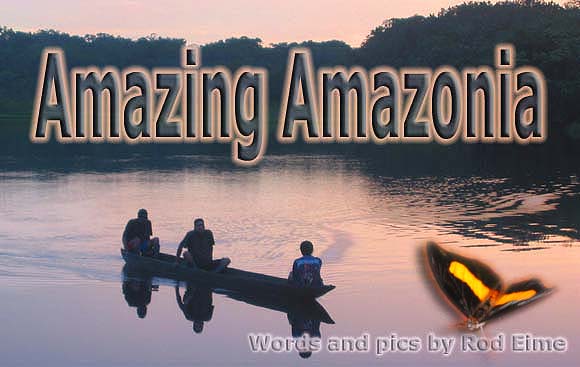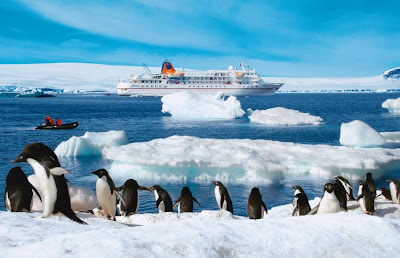// January 2nd, 2006 // No Comments » // South America, Travel

By Roderick Eime. Pics by the author.
The jungle is almost silent. A mossy natural junkyard of tree corpses and opportunistic vines line either side of the narrow rivulet while tall, spindly kapok trees merge overhead to form a verdant archway. Invisible birds call sporadically to each other in shrill chirps shattering the silence like distant gunshots. Chuka is perched precariously on the very rear of the slender canoe and barely makes a sound as his paddle caresses the still black water while my eyes dart in all directions fruitlessly trying to locate the source of these occasional noises.
The archetypical Amazonian Indian, Chuka is long-haired and cherub-faced with bright, laser focussed eyes continually scouring the canopy for any sign that might indicate wildlife. Hunting (photographically) for prey in the dark anarchic igapo is both exciting and frustrating. Subjects don’t come and neatly present themselves at a conveniently pre-focussed distance, rather duck and weave in and out of the foliage at the furthest reach of your telephoto lens – if you can even see them! A Cocoi Heron peers at us from behind a large palm frond while a colourful Macaw perches way up in the canopy.
Then there’s something – deep in the forest. To me it’s just another random shrill. To Chuka it’s an alarm! In a hushed but urgent tone, he urges me, “Monkey come!” My impatience and frustration is already showing, but Chuka knows his careful efforts are about to yield results. “There!” he motions frantically toward a distant kapok frond bobbing tell-tale against the rain laden sky. I can barely make out the silhouette of a tiny squirrel monkey as it explores the loftiest branches in search of ripe morsels. Presented with this meagre opportunity, I put down my SLR and instead video the little rascal as he darts in and out of the tree forks and leafy clumps.
“There, there, there!” explodes Chuka, his lean brown arm extended in six directions at once. Left, right, up, over! Damn! Where now? While I was concentrating on the pathfinder, the rest of the troupe had caught up and were now crashing noisily from branch to branch and launching themselves across the gulf between trees. It was raining monkeys!
Oh, for a ball-jointed spine. I try painfully to orientate myself toward each little honey-brown and white opportunity as they poke their faces out from bushy nooks and crannies before launching themselves deeper into the trees. All the while I am haunted by the fearful thought of capsizing the narrow canoe with my twitching, clumsy bulk. By now I’m shooting at everything that moves; knowing that a scant handful of shots will be useful after the commotion is over. But the experience, on its own, is exhilarating.
My three days in the dense Amazonian headwaters of eastern Ecuador were barely a glimpse at the enormous variety of wildlife and flora found in this unique environment, and yes, I did manage a few decent snaps. Here the term “biodiversity” takes on a whole new meaning. Try to imagine 250 species of tree per hectare and 573 species of birds! Although you are literally tripping over the plants, the fauna, despite its profusion, is much harder to locate. Each find is a discovery in itself and usually the result of hours of patient searching.
Sacha Lodge is just one of many secluded retreats where you can enjoy a genuine Amazonian experience. It’s located 80 kilometres east of the town of Coca in the east of country. The journey there is an experience in itself and adds to the mystique of this remote location. After a fortifying breakfast, you leave your Quito hotel for the airport, then half an hour by 20-seat airplane and you’re in Coca. A quick stop for a coffee and banana, then it’s two hours by motorised canoe down the Rio Napo where you disembark and walk (don’t worry, your luggage is carried for you) a further 45 minutes to the edge of a mirror-still lake. Then you are paddled skilfully across to the lodge jetty where you are welcomed by the staff.
As mentioned, my brief, 3-day visit was but a mere flirtation with the wonders of the jungle. Sure, it was enough for a taste of the adventure, but left me longing for a repeat experience. Even though you are many miles from civilisation, the jungle lodge still maintains a level of comfort suitable for the urban softie like me, but enough of the wild, untamed primeval forest to be a genuine adventure.
Short as my stay may have been, I still managed to immerse myself in everything on offer whether it was hiking in the dark varzea and igapo (jungle floodplain), climbing a 50m observation tower or fishing for Piranha in the lake. Even a casual stroll around the lush grounds of the lodge yielded results. Shy black mantled tamarins often come down for a snack on the banana trees, furry agouti forage in the leaf litter while tiny pygmy marmosets can be found dining on tree sap.
There are numerous lodges catering to this adventure market, and each has its own special range of activities and features. Sacha Lodge, for instance, has a butterfly farm that assures you of an abundant up-close-and-personal experience with these delicate Amazonian beauties. Others will have special bird- or animal-watching facilities that capitalise on the immediate region’s highlights.
Still in Ecuador, the acclaimed Kapawi Lodge is located on the Pastaza River, deep in the Amazon basin. Based on architectural principles of the local Achuar tribe, Kapawi is constructed without the use of a single metal nail and makes extensive use of environmentally friendly, state-of-the-art building methods. Access to Kapawi is by light plane to Sharamentsa, then downriver by comfortable canoe.
Across the border in Peru is another array of lodges accessible from the gateway town of Iquitos, located directly on the Amazon River itself. The Ceiba Tops Lodge and Resort will appeal to those more accustomed to “conventional” accommodation; hence some of the virgin jungle appeal may be lost. Ceiba Tops boasts fifty-three air conditioned rooms, swimming pool and a convention centre. Wildlife excursions are extra.
Apart from the popular lodge stays, Amazon cruising is another way of getting amongst the varied eco-systems in this rich area. One typical vessel, The Amazon Clipper, is an authentic 20 metre river boat that operates from the centrally located Brazilian town of Manaus near the convergence of the Amazon and the Rio Negro. It carries up to 16 passengers on 2, 3 and 5 night itineraries, making full use of the nearby January Ecological Park. One of the highlights is the Victoria Regia (Water-lily) lake.
Travel facts
Getting There
Lan Chile flies to Quito and Lima via Santiago. Each lodge will have its own individual transfer arrangements which involve internal flights in smaller planes. For those who thrive on detail, I flew to Coca in Ecuador with Saereo, firstly in an Embraer EMB-120 Brasilia and by Beech 1900D on the return. Austro in Ecuador, Lan Peru and Aero Continente are others to service these destinations.
The smaller airports are subject weather delays and other minor inconveniences so don’t book a tight schedule with your next transfer. Allow 24 hours.
You will most likely arrive at your lodge by boat of some sort. In the case of Ceiba Tops, it will be a modern, all-metal vessel, whereas the more remote lodges are accessed via motorised canoe. Sturdier than they sound, these boats will carry 20-30 passengers on movable benches. You’ll wear a life-jacket and be seated under a fabric canopy.
Getting Around
Once you’re ensconced in your selected lodge, most travel will be by foot. Lodges generally provide gum-boots for jungle hikes. Other local excursions can be by paddled canoe where, as you have read above, allow access into the dense jungle floodplains and minor tributaries.
Tips
Insect repellent, as you’ve already guessed, is a must. However, bugs are an important part of the fragile jungle eco-system, so don’t go hosing yourself with wasteful, unfriendly aerosols. Consider roll-ons or creams – and they’re cheaper, last longer and travel better.
Your lodge will recommend that you travel light. A single backpack and day bag should get you through. Leave heavy suitcases back at your city hotel – you’ll thank me.
When making a choice about which lodge to visit, try and make your stay worthwhile with a visit of as long as possible. Amazonia is both relaxing and exciting, but a hurried visit will leave you wanting.
Further information
Lodge web sites
Sacha Lodge – www.sachalodge.com
Ceiba Tops and others – www.explorama.com
Kapawi Ecolodge – www.kapawi.com
Amazon Clipper – www.amazonclipper.com
Tour Operators
Adventure Associates www.adventureassociates.com (02) 9389 7466
Fact-Box
• The Amazon Basin holds around 40% of the world’s fresh water, covers an area almost the size of Australia and includes Peru, Ecuador, Columbia and Brazil.
• Over 1,000 rivers flow into the Amazon itself.
• The Amazon is the world’s largest river by volume and second longest after the Nile. Its discharge at the mouth is approximately 7 million cubic feet per second.
• The Amazon and the Tropical Andes contain the greatest terrestrial and freshwater diversity on the planet.
• 25,000 square kilometres of Amazon rainforest was cleared between July 2001 and June 2002. (10 times the size of the ACT) (source INPE)





